Country guides

Things to do in St Lucia
The pristine beaches and emerald waters of St Lucia draw in hordes of visitors every year. The island has earned the title of world's leading honeymoon destination no fewer than eight times, and with good reason.
Most guests arrive on cruise liners at the island's main port, Castries, where they can go hunting for souvenirs at the Castries Central Market. Many then head for the white sands of Sugar Beach and enjoy snorkeling in the crystal clear waters.
More adventurous souls can enjoy a mountain bike ride beneath the dense rainforest, or brave a zip-line tour through the tree canopies. A visit to the fascinating Soufriere Volcano with its bubbling sulphur springs is not to be missed. Likewise the UNESCO-listed twin peaks of the Pitons, which await the daring hiker. Diamond Falls Botanical Gardens offers a stunning retreat from the world, with its astonishing variety of tropical fauna and flora, hot mineral springs, and rainbow coloured waterfall. The Pigeon Island National Park is also popular among tourists for its pristine beaches. For the best panoramic views of the island, visitors can hike up to the old town of Vieux Fort.
Not just the domain of the newly weds, St Lucia has plenty for the whole family. Children can enjoy attractions such as the safe swimming beach of Anse Chastanet, and pirate-themed sea adventures.
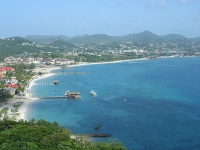
Gros Islet
North of Castries lies the small, rather unremarkable fishing village of Gros Islet, a collection of dilapidated wooden homes lining narrow streets and a rather grubby beach. Howev…
Gros Islet
North of Castries lies the small, rather unremarkable fishing village of Gros Islet, a collection of dilapidated wooden homes lining narrow streets and a rather grubby beach. However, come Friday night this seemingly unexceptional town is the place to be for everyone on St Lucia, local or visitor.
The renowned Friday night 'jump-up' starts at around 10pm when the streets are blocked off. Scores of vendors arrive with delicious snacks and cold beers, bars open their doors and speakers are set up on street corners. The party goes on most of the night.
Gros Islet also offers daytime activities for families. Children as young as two years old can enjoy riding at the International Riding Stables with trained guides, while older children can enjoy riding ahead, depending on their level of experience.
Children will love the riding tour with a beach picnic at Cas en Bas, which includes a scenic ride through the countryside and a stop on the beach for swimming and cantering through the lapping waves.
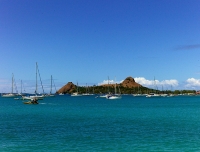
Pigeon Island
Pigeon Island, north of Castries, is St Lucia's first national park, and is reached from the mainland across a causeway. The islet has a romantic past, having been the hide-out of …
Pigeon Island
Pigeon Island, north of Castries, is St Lucia's first national park, and is reached from the mainland across a causeway. The islet has a romantic past, having been the hide-out of Jambe de Bois, the much-feared peg-leg pirate who preyed on Spanish galleons. It was also from here that Admiral Rodney set sail in 1782 to destroy the French fleet in one of the most decisive sea battles in European history.
Pigeon Island features two white-sand beaches and an interpretation centre, where a multimedia display explains the local history. The centre includes the Captain's Cellar Olde English Pub, a re-creation of an 18th century English pub. The island is ideal for nature walks and has many marked trails that bypass historical sites, such as the remains of an 18th century British fort.
Website www.slunatrust.org
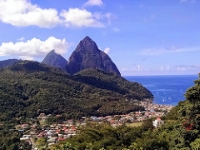
Soufriere
Soufriere in the south is the oldest settlement on the island, having served as the French capital in the 18th century. The deep-water port stands at the base of St Lucia's main la…
Soufriere
Soufriere in the south is the oldest settlement on the island, having served as the French capital in the 18th century. The deep-water port stands at the base of St Lucia's main landmarks, the two towering extinct volcanoes known as the Pitons, which rise to 2,619 feet (798m) above sea level. The town itself is pretty, with a cluster of colourfully painted arcaded buildings against the backdrop of dense jungle.
Most visitors, however, are drawn by the nearby attraction of the 'drive-in' volcano, Mount Soufriere, where it is possible to enter by car into an ancient volcanic crater filled with sulphur springs and steam geysers. Also at Soufriere are the Diamond Mineral Baths, the Diamond Waterfall and the Diamond Botanical Gardens.
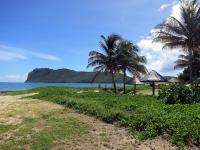
Vieux Fort
St Lucia's second largest town is on the south coast, adjacent to the island's busy Hewanorra International Airport on the southernmost tip of the island. At St Lucia's most southe…
Vieux Fort
St Lucia's second largest town is on the south coast, adjacent to the island's busy Hewanorra International Airport on the southernmost tip of the island. At St Lucia's most southerly point just outside the town is the Cape Moule, a Chique Lighthouse, which offers one of the best panoramic views of the island. The town has a beach called Anse de Sables that is popular for windsurfers. Near the beach is the Maria Islands Interpretive Centre, which contains a small natural history museum and an office where visitors can book trips to the Maria Islands about half a mile offshore.
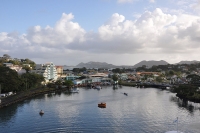
Castries
Castries is best known as a port of call for the multitude of cruise ships that dock in the harbour each year, rather than for sightseeing opportunities. However, visitors who ling…
Castries
Castries is best known as a port of call for the multitude of cruise ships that dock in the harbour each year, rather than for sightseeing opportunities. However, visitors who linger can enjoy the lively market on Jeremie Street, wander through Derek Walcott Square (so-named in honour of the Nobel Prize-winning poet), and take in the views over the harbour from the top of Morne Fortune.
Most of the buildings are fairly new, Castries having been destroyed several times by fire during its history, most recently in 1948. One of the main attractions still standing is the Cathedral of the Immaculate Conception. Built in the late 19th century, it is the largest cathedral in the Caribbean, and home to a collection of colourful frescoes.
There are a handful of good restaurants on the waterfront. Some remains of the defences put in place by the island's various occupiers still stand to draw the attention of visitors. Castries also serves as a good base for exploring the island, whether by land or by sea.
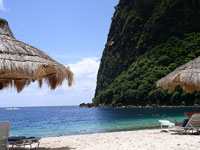
Beaches
St Lucia is a tropical paradise of pristine white-sand beaches and perfectly clear emerald waters. Nonchalant about its breathtaking beauty, travellers can pop onto any of its magn
Beaches
St Lucia is a tropical paradise of pristine white-sand beaches and perfectly clear emerald waters. Nonchalant about its breathtaking beauty, travellers can pop onto any of its magnificent shores as they're all public.
Marigot Bay is perhaps the destination's most beautiful beach, and it's a masterpiece of lush hillsides that plunge to a pretty palm-fringed coast. Anse Louvet is one of the best beaches for snorkelling, while the sheltered bay at Anse Chastanet is great for younger and more inexperienced swimmers. Divers should note that Anse Chastanet has a coral reef that harbors a treasure trove of sea life, including parrotfish, goatfish, wrasse, chromis and barracudas.
About a 10-minute walk from Anse Chastanet, Anse Mamin is less crowded, with a lovely secluded feel and great snorkeling. Anse Cochon and the solitary beaches on Anse Comerette are other favourites.
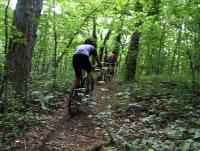
Jungle Biking
Although St Lucia's mountain bike trails may not be the easiest in the world, they are definitely some of the most beautiful. An attraction geared more towards older children and a…
Jungle Biking
Although St Lucia's mountain bike trails may not be the easiest in the world, they are definitely some of the most beautiful. An attraction geared more towards older children and adults, jungle biking is a great way to see the island and get outdoors with the family for a fun-filled day.
Bikers will ride past the ruins of an 18th-century French-colonial sugar mill, an old church, and a reservoir. There are plenty of great locations to stop for a picnic, and seasoned bikers can take the Tinker's Trail for a thrilling ride. Children's bikes and helmets are available to rent.
Website www.bikestlucia.com
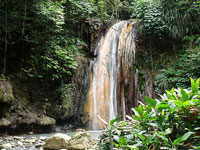
Diamond Waterfall
The Diamond Falls section of the Soufrière Estate is a treat for nature lovers, who can enjoy three of St Lucia's most popular attractions when they visit. A walk through the Diam…
Diamond Waterfall
The Diamond Falls section of the Soufrière Estate is a treat for nature lovers, who can enjoy three of St Lucia's most popular attractions when they visit. A walk through the Diamond Botanical Gardens will never fail to raise the spirits, thanks to an abundance of coconut, cocoa, mahogany and red cedar trees. There are shrubs and tropical flowers from around the world as well, and educational displays of local fruits and vegetables, such as christophine, soursop and dasheen, round out the experience.
The healing mineral hot spring baths were originally built for King Louis the XVI of France, but are open to everyone today and, of course, the waterfall is a feast for the eyes. Created by the water from the bubbling sulphur springs of the Diamond Mineral Baths, the waterfall changes colours a few times a day, going from yellow to black, then green and finally grey.
Website www.diamondstlucia.com
Castries Central Market
For cruise passengers to St Lucia, the Castries Central Market will be the first port of call for those looking to stretch their legs, do some shopping and take in some local cultu…
Castries Central Market
For cruise passengers to St Lucia, the Castries Central Market will be the first port of call for those looking to stretch their legs, do some shopping and take in some local culture. This wonderful fresh goods and produce market provides a great introduction to the vibrancy and colour of St Lucia, as well as a tasty introduction to its incredible range of fresh fruits and vegetables.
There are also numerous food stalls in the Castries Market, selling local favourites such as freshly prepared curries and jerk dishes. Across the road from the Central Market is the Vendor's Arcade, which is probably the best place to shop on the island for crafts, curios and souvenirs.
Visitors looking to take advantage of duty-free deals should head to Pointe Seraphine (located on the northern end of Castries' harbour), where a modern mall offers discounted prices on items such as liquor (especially local rum), perfumes and jewellery.
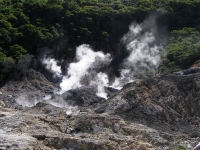
Sulphur Springs
Known as the 'world's only drive-in volcano', Sulphur Springs is a popular tourist attraction for visitors to St Lucia. Located near the gorgeous town of Soufriere, it is a dormant…
Sulphur Springs
Known as the 'world's only drive-in volcano', Sulphur Springs is a popular tourist attraction for visitors to St Lucia. Located near the gorgeous town of Soufriere, it is a dormant volcano (some scientists say that it is due to erupt within the next 100 years), and the on-going physical and chemical processes at the site are at once thrilling and deeply interesting to experience.
The first thing visitors will notice as they approach Sulphur Springs is the overwhelming smell of sulphur in the air. In fact, the presence of sulphur is so strong in the area that visitors shouldn't wear any silver jewellery in case it gets discoloured. Once inside and from the safe confines of a boardwalk, tourists can gawk at seething, bubbling mud pots and their 50-foot steam vents rising from the volcanic crater, and admire the strange orange, purple and green streaks left on the surrounding rock by mineral deposits.
The highlight of the visit is the chance to take a hot bath in the sulphur-enriched mud, which supposedly does wonders for the sinuses. A unique and exciting attraction, travellers should budget at least two hours to take it all in.
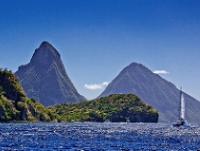
The Pitons
The Pitons are two volcanic plugs that stand like sentinels on the headland outside the St Lucian town of Soufriere. Not only are they UNESCO World Heritage Sites, but they provide…
The Pitons
The Pitons are two volcanic plugs that stand like sentinels on the headland outside the St Lucian town of Soufriere. Not only are they UNESCO World Heritage Sites, but they provide active visitors with a glorious opportunity to do some hiking in what are uniquely picturesque surrounds.
Gros Piton, with an elevation of about 2,500 feet (770m), is the more popular to climb, as it's not as steep at Petit Piton, and boasts a richer variety of plant and animal life as well as superior views from its summit. The trail that leads up Gros Piton begins at an elevation of about 600 feet (180m), and ascends quite sharply through dense tropical vegetation, broken here and there by cool caves and rocky outcrops that provide outstanding views of Petit Piton rising from the expanse of the Caribbean Sea below.
The climb takes about four or five hours in all, and can be undertaken by fit visitors with little or no mountaineering experience. Local guides, trained in emergency medical procedures, are available for hire and will enrich the hike by pointing out interesting flora and fauna along the way.
Website whc.unesco.org/en/list/1161


